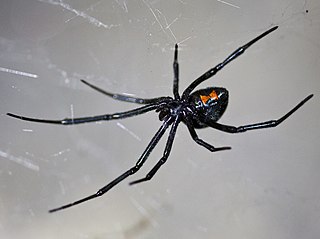
The Thomisidae are a family of spiders, including about 175 genera and over 2,100 species. The common name crab spider is often linked to species in this family, but is also applied loosely to many other species of spiders. Among the Thomisidae, "crab spider" refers most often to the familiar species of "flower crab spiders", though not all members of the family are limited to ambush hunting in flowers.

Wolf spiders are members of the family Lycosidae, from the Ancient Greek word "λύκος" meaning "wolf". They are robust and agile hunters with excellent eyesight. They live mostly in solitude and hunt alone, and do not spin webs. Some are opportunistic hunters pouncing upon prey as they find it or even chasing it over short distances. Some wait for passing prey in or near the mouth of a burrow.

Jumping spiders are a group of spiders that constitute the family Salticidae. As at 1 February 2019, this family contained 636 described genera and 6115 described species, making it the largest family of spiders at 13% of all species. Jumping spiders have some of the best vision among arthropods and use it in courtship, hunting, and navigation. Although they normally move unobtrusively and fairly slowly, most species are capable of very agile jumps, notably when hunting, but sometimes in response to sudden threats or crossing long gaps. Both their book lungs and tracheal system are well-developed, and they use both systems. Jumping spiders are generally recognized by their eye pattern. All jumping spiders have four pairs of eyes, with the anterior median pair being particularly large.

Huntsman spiders, members of the family Sparassidae, are known by this name because of their speed and mode of hunting. They also are called giant crab spiders because of their size and appearance. Larger species sometimes are referred to as wood spiders, because of their preference for woody places. In southern Africa the genus Palystes are known as rain spiders or lizard-eating spiders. Commonly they are confused with baboon spiders from the Mygalomorphae infraorder, which are not closely related.

Latrodectus is a broadly distributed genus of spiders, which is composed of both black widow spiders and brown widow spiders. A member of the Theridiidae family, this genus contains 31 species, including the North American black widows, the European black widow, the Australian redback black widow and the button spiders of Southern Africa. Species vary widely in size. In most cases, the females are dark-coloured and readily identifiable by reddish markings on the abdomen, which are often hourglass-shaped.

Pholcidae, commonly known as cellar spiders, are a spider family in the suborder Araneomorphae. The family contains about 1500 species divided into about 80 genera.

The sac spiders of the family Clubionidae have a very confusing taxonomic history. Once, this family was a large catch-all taxon for a disparate collection of spiders, similar only in that they had eight eyes arranged in two rows and conical anterior spinnerets that touched, and were wandering predators that built silken retreats, or sacs, usually on plant terminals, between leaves, under bark, or under rocks. These are now recognized to include several families, some of which are more closely related to the three-clawed spiders, like lynx and wolf spiders, than to Clubionidae and related families.

Linyphiidae is a family of very small spiders, including more than 4,300 described species in 601 genera worldwide. This makes Linyphiidae the second largest family of spiders after the Salticidae. New species are still being discovered throughout the world, and the family is poorly known. Because of the difficulty in identifying such tiny spiders, there are regular changes in taxonomy as species are combined or divided.

The white-throated bulbul is a species of songbird in the bulbul family, Pycnonotidae. It is found in south-eastern Asia from the eastern Himalayas to Myanmar and western Thailand. Its natural habitat is subtropical or tropical moist lowland forests.

The yellow-bellied bulbul is a species of songbird in the bulbul family, Pycnonotidae. It is found on the Malay Peninsula, Sumatra and Borneo. Its natural habitat is subtropical or tropical moist lowland forests.

The yellow-bellied greenbul is a species of songbird in the bulbul family, Pycnonotidae. It is found in eastern, southern and west-central Africa. Its natural habitats are subtropical or tropical dry forests, subtropical or tropical moist lowland forests, and dry savanna.

The grey-headed greenbul, or grey-headed yellow-bellied greenbul, is a species of songbird in the bulbul family, Pycnonotidae. It is found in south-eastern Nigeria and western Cameroon.

The song wren is a species of bird in the Troglodytidae family.

The sooty-crowned flycatcher is a species of bird in the family Tyrannidae. It is found in Ecuador and Peru. Its natural habitats are subtropical or tropical dry forests and subtropical or tropical moist lowland forests.

Tarantulas comprise a group of large and often hairy arachnids belonging to the Theraphosidae family of spiders, of which about 900 species have been identified. This article only describes members of the Theraphosidae, although some other members of the same infraorder (Mygalomorphae) are commonly referred to as "tarantulas". Some species have become popular in the exotic pet trade. New World species kept as pets have urticating hairs that can cause irritation to the skin and, in extreme cases, cause damage to eyes.

Juncus phaeocephalus, the brown-headed rush, is native mostly along the coast of California, north to Oregon and Washington. It grows in moist seeps and shallow wet soil.

















